Tales of the land girls shared at Maungati
by Simon Edwards
Among the crowd of more than 120 who travelled to Maungati, near Timaru, on Sunday to remember the World War II ‘land girls’ were two particularly special guests – Sadie Lietze (nee Stuart) and Daphne Attfield (nee Williams).
Now in their late 90s, the pair represented the last of the ranks of the New Zealand Women’s Land Service (WLS). Like Joan Butland of Auckland, whose health didn’t permit her to make the trip south, they were among the more than 2,700 young women aged 17 to their early 20s – many of them from the cities - who in the 1940s kept farms and orchards going when men were called up to fight. Their efforts were crucial in an era when New Zealand was still the offshore farm of Britain and locals as well as tens of thousands of American servicemen in the Pacific needed to be fed.
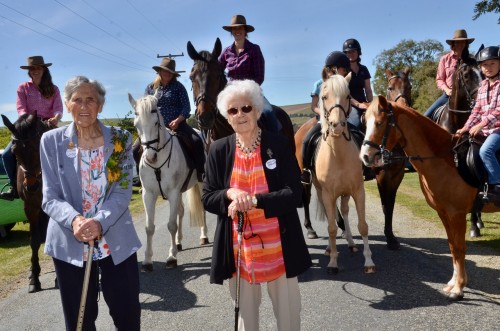
Former land girls Sadie Lietze (left) and Daphne Attfield with young women from the Dale and Rowley families who mounted up for the celebration.
After unveiling a commemorative plaque on a new seat given pride of place in the Elworthy family’s Rongomaraeroa (Long Pathway to Peace) gardens adjacent to the Maungati hall and school, Sadie and Daphne joined in singing wartime songs such as We’ll meet again and Lily Marlene. They spent much of the afternoon answering visitors’ requests for their recollections of what it was like to be a land girl.
Unlike so many of the land girls, who in a more strict gender-defined era left roles as secretaries, hairdressers and the like to be confronted with totally unfamiliar tasks such as crutching sheep and shooting rabbits, Sadie had grown up on a dairy farm on the Otago Peninsula. The family had been forced off the land during the depression and it was while working in a milk bar in Dunedin’s Octagon that she saw a recruitment post for the Women’s Land Service.
She was sent to Omarama to work on Tara Hills, a high country sheep station. She was up at 6am every day to milk cows and was expected to catch and saddle up the children’s ponies so they could ride to school. She took on roles as musterer, wool classer, horse breaker, assistant rabbiter and general rouseabout.
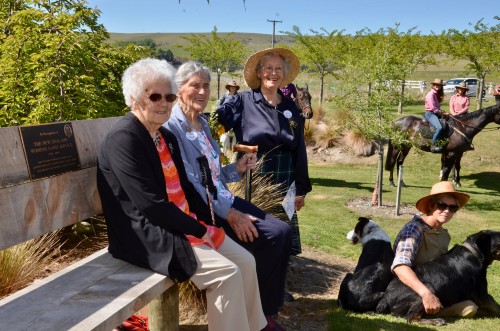
Sadie and Daphne with Fiona, Lady Elworthy, by the new seat and plaque unveiled on the day. Nicky Crabbe, with her heading dog Faye and huntaway Wag, dressed in overalls typical of those worn by the land girls and read the Land Girls poem by Mary Robinson.
There was no electricity. A Delco engine charged batteries for light, and the wireless she and the family would listen to for news of the war at 9pm each night.
For two years Sadie slept in an old tin hut, with a candle for light and sacks she could throw on her bed for extra warmth during the bitter winter months. But she recalls the meals were hot and nutritious, and her weekly bath was a treat.
At age 21, Sadie asked to be transferred. She then spent eight months on a farm in Kelso in West Otago, where she was treated like a daughter until the war ended and the Women’s Land Service was disbanded.
Daphne also grew up on a farm. In fact, her time in the WLS was served on her parent’s Mataura dairy property simply because with her brother serving in the navy, her father said he couldn’t do without her if he was to continue producing food for the war effort.
“So I found it no particular hardship, but some of the girls – especially the ones who weren’t used to it – had a hard time.”
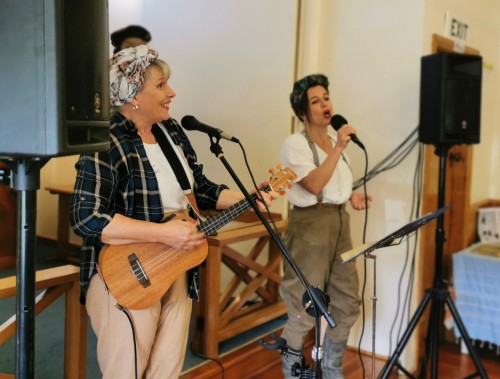
Lorina Harding and Jill Griffen Roberts led the singing of wartime songs on Maungati Hall.
But for the farms where the land girls had been so crucial, their service was for several decades after the war largely forgotten. As Land Girls – In a Man’s World author and guest speaker Dr Dianne Bardsley noted, NZ’s Archives have no substantial records of the Women’s Land Service despite it being the nation’s largest women’s war service.
However, from the 1980s Joan Butland began organising WLS reunions and Daphne – who later married a merino sheep farmer from the high country – enjoyed them immensely.
Former Federated Farmers President Dr William Rolleston was one of several speakers to pay tribute to Fiona, Lady Elworthy, for pulling together the weekend celebration at Maungati.
Like others there, William’s family also has stories of the land girls era.
His grandfather was manager of the 4000ha Blue Cliffs Station in south Canterbury.
“When in October 1941 he headed up to Trentham to take up medical duties, he left my grandmother as manager of the station. A few months later my mother Carne (nee Woodhouse), who had just finished school and celebrated her 18th birthday, started her job as a land girl at Blue Cliffs.
“Within a year there was only one man still working at Blue Cliffs. There were five land girls and my grandmother and it was a tough time for them. They tackled just about everything.”
They managed without the station’s truck, which like many of the horses and rifles had been commandeered for the war effort.
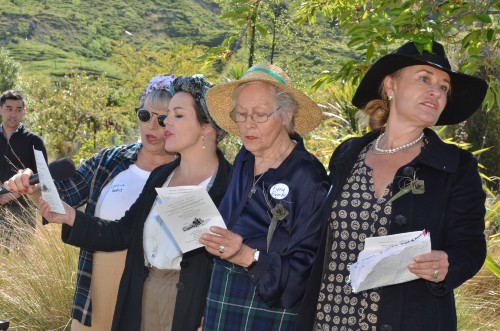
Singers Jill Griffen Roberts and Lorina Harding with Lady Fiona Elworthy and her daughter Jospehine. It was a beautiful sunny day for the celebration, even if some of the farmers - with an eye to very dry pasture - might have wished it rained.
One of the stories that became Rolleston family legend related to the fact the overalls, wooden clogs (gumboots were hard to come by as the war went on) and other gear given to the land girls to wear was not particularly warm.
“My mother and the other girls went into men’s stores to shyly ask for long-johns ‘for a man of about my size’.”
Another time they’d been looking forward to attending a dance in Christchurch, and had saved the week’s petrol ration for the car trip to St Andrew’s. But mustering day high up on the wether run had been postponed the day before because fog had rolled in. So on the day of the dance, with a 2am start on horseback to get up to the hilltops to begin mustering, they came back down in the afternoon and had to change into their party clothes during the car ride to the train station at St Andrews.
“They made it to Christchurch but I can’t imagine what state they were in after such a long day of work. But needs must in those days, I guess,” William told the crowd.
“After the war finished, most of the land girls went back to do other things. Some didn’t. If I think about the careers of some of the local women….Fiona’s daughters Josephine and Eve, my wife Marion, they did something different from farming but they’re all capable farmers in their own right and could have run any of the properties around here but chose not to,” William said.
We’ve just had an election in which two women competed to be Prime Minister; our Chief Justice is a woman, and our Governor General.
“I was proud, and I know Sir Peter (Elworthy) would have been proud, that a woman (Katie Milne) followed me as President of Federated Farmers,” William said.
“Just as the first World War was New Zealand’s coming of age, it could be said that the second World War was women’s coming of age. It’s been a journey from Kate Shepherd till now and we’re still on that journey.
“The Women’s Land Service was a significant part of that journey.”
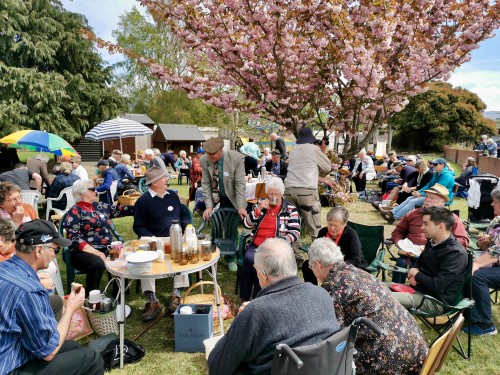
The day finished with a picnic, and plenty of reminiscing.